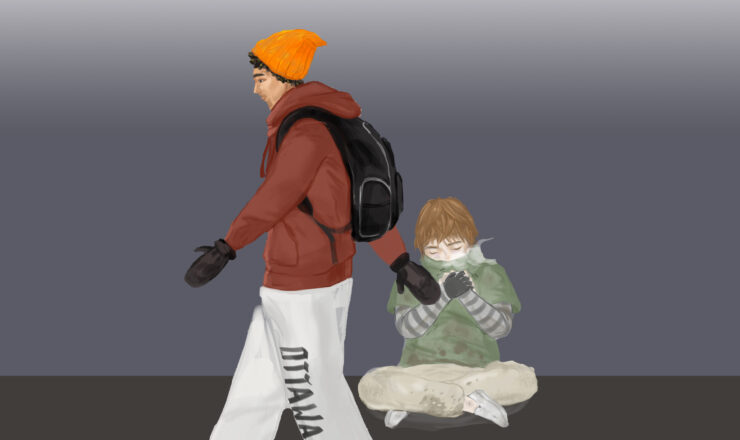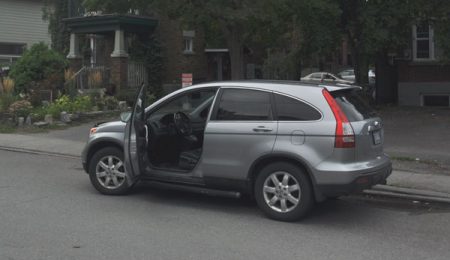Conversation around homelessness must extend beyond the latest cold snap
The latest reports of frigid temperatures have thrown the issue of homelessness into the spotlight once again.
One of the solutions recent articles have thrown into public view is the need for more emergency shelters in the cold Canadian winter. This is obviously the most pressing concern, however if we want to avoid being stuck repeating last-ditch measures every year in the future, we need to take time to consider the long-term options for reducing and ending homelessness in Canada.
An important part of this discussion is looking at the root causes of homelessness, and the groups that are most prominently affected. And yes, this can include college and university, secondary, and younger students.
Scope of the problem
There are several predictors to homelessness in Ottawa, and in Canada as a whole: income rates, discrimination, housing prices and policy, cooperation of different agencies, and prevention policy. It’s a lot to take on, but there are plenty of people working diligently to solve these problems. And there are a lot of problems.
But before we get there, what are the major issues facing homeless people in Ottawa, and across the nation?
Kaite Harris is project manager at Alliance to End Homelessness, A Way Home Ottawa. Unsurprisingly, she says that housing is one of the big issues facing homeless people.
“Something we’re urging very much is leaders, federally, provincially, and municipally … we need affordable housing so badly, this is such a supply and demand issue in many ways,” said Harris.
“Right now, we’re funded through different streams, it’s super complex, different people measure different things because different funders want them to measure differently, and as a result, it’s super convoluted for people to get the service they actually need quickly and efficiently,” said Harris.
Joey Clavette is the founder of the Wrench newspaper, which looks at issues facing homeless people in Ottawa. “Life becomes too complicated,” he said. “A lot of these important structures that keep somebody’s life grounded kind of fall out.”
According to Tim Aubry, a professor of psychology at the University of Ottawa and a senior researcher at the centre for research on educational and community service, a major factor is simply income. And this, he says, is often paired with other problems such as health issues, addictions, and social isolation.
And before delving any deeper, what would “solving” homelessness really mean? “It would mean that if people find themselves out of housing, they would be helped immediately to get back,” said Aubry. “The key is if they do end up homeless, they get connected to the right services very quickly and they get back into housing very quickly.”
Clavette says he finds it surprising that people aren’t more shocked by our current state of affairs. “We’ve accepted a status quo of homelessness … It should be seen as something very strange, especially in a country that’s so rich.”
Homelessness among university students
Harris says that she has heard of instances where people enrolled in university experience homelessness as well, ranging from being forced to stay on friend’s couches to living in shelters.
“I know one guy in particular who was at the shelter, and he was managing to get his courses done, and moved through his work at Carleton, but was in a context where he had to check in at a shelter every night, which is super loud and chaotic and very tiring,” said Harris.
One of the main ways to alleviate homelessness in the general population is to make a concerted effort to stave off homelessness among young people, Harris says. “If we’re ending youth homelessness we’re actually ending adult homelessness, and people who often become chronically homeless as adults.”
“I definitely think there may be an element of homelessness that we really don’t see or know about very much, for students, where they are just not able to pay rent for whatever reason.”
Youth homelessness
There are several obvious reasons to focus on homelessness among young people. One important aspect is that youth homelessness is a leading indicator of homelessness throughout a person’s life. According to research by A Way Home, it can begin earlier than what you might think. Some children experienced homelessness for the first time at ages as young as 10 or 12.
And once a young person is thrown into homelessness, it doesn’t take long for them to get stuck in the cycle. A Way Home also found that 40 per cent of young people who are homeless after the age of 16 had already experienced homelessness earlier in their lives.
“We have about two months, the research says, before a young person ends up being entrenched in street life,” said Harris. “if they’ve spend two months living on the street they’ve probably experienced all kinds of victimization, violence, sexual violence, potential for trafficking, for human trafficking and for trafficking drugs, for getting involved in substance use, and mental health challenges.”
She added that stopping this process quickly is essential. “If we can get ahead of the curve, and make sure kids don’t end up, and that we divert them from ending up at that place, and provide the support that they need early, we can be a lot more successful at seeing long-term supports.”
Aubry adds that even among youth, there are specific groups that are especially at risk of homelessness. LGBTQ+ youth, for example, are more likely to become homeless, as are Indigenous youth. He says that social marginalization is likely to be a factor in the higher risk for these groups.
And it often happens that all the logistical issues that can come with homelessness are only magnified for young people.
“When kids are homeless, maybe coming in from a case where they don’t have a lot of support around them, and it’s all brand new, they may not have the knowledge or access to the knowledge of all those pieces, and it’s easy to get taken advantage of,” said Harris. “Right now, it’s pretty complex, and a lot of young people talk about how difficult it is to navigate getting the services that they need to get the help they need.”
According to Aubry, a big issue is transitioning youth from Child Services to living on their own, and he says this is where many young people fall through the cracks. “A lot of those kids come out of Children’s Aid, foster care, and they don’t have a family to fall back on,” he said.
Youth Solutions
One of the most effective ways to curb youth homelessness is to focus on schools, Harris said.
“When you can intervene at the school level, it’s sooner than when people may be at such a crisis point that they’re fully homeless or they’re in the system,” she said. She added that proactively working with families to intervene in problematic situations before they lead to full-fledged homelessness.
Aubry also emphasized working with youth leaving Child Services specifically. “I think we can do some important prevention work here,” he said, adding that they make up almost half of those experiencing youth homelessness. He adds that if a young person has left school, getting them back to school is an important piece of the puzzle.
Aubry also notes that getting to people as young as possible is important. He advocated a strategy called “Housing First”, which looks to “get people some help on the financial side, combined with some support.” This could include rent supplements, for example, combine that with support, like a caseworker. He says it’s been a success so far. “That has had tremendous success at moving the majority of people who participate in those programs to housing.”
Aubry notes that the Canadian Mental Health Association branch in Ottawa ran one such program, as did the Sandy Hill community centre, and the City of Ottawa. While he says the programs have been effective, he notes that there are still around 600 to 700 people who are chronically homeless in the city, and so we need to grow our housing first programs.
“We know what can help, we just need to mobilize things and get the right resources in place,” he said.
What can the rest of us do?
Even if you’re not part of government or an NGO, you can still play a role in the process. “In so many ways, this is like a group project, where we’re all on the hook, and I mean that as community members and neighbors,” said Harris.
She says that this can range from parents noticing when their kid’s friend is sleeping over a lot, to people advocating their governments to change the relevant policies.
Homelessness can affect pretty much any category of person with low income: youth, adults, families, and yes, even university students.
While homelessness in Ottawa and the rest of the country gets the most coverage when there are extremely pressing crises, whether related to cold snaps or the fentanyl crisis, to make a real mark on the problem we need to focus on long-term solutions as well.
Depending on different groups who are more prone to homelessness, there are varying degrees of research. One trend that is clear, however, is that focusing on stopping homelessness among young people is an important part of eliminating homelessness.
Aubry, for his part, remains optimistic. “We can end homelessness.”
—With files from Savannah Awde.





